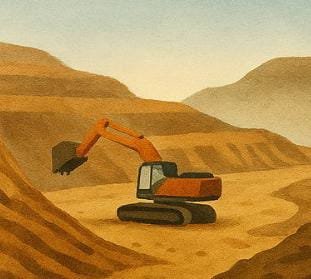
What Happens After a Mine Closes?
When a mine shuts down, the job isn’t finished. In fact, the most important phase is just beginning—land reclamation. But what really happens to the land once mining operations stop? Can it truly be restored?
This article explores the reality behind post-mining land, the process of reclamation, and the challenges that come with it.
- The Scar Left Behind
When the machines leave, the land is often barren, broken, and unstable. Open pits, leveled hills, and contaminated soil mark the aftermath of extraction.
Without a post-mining plan, these areas can become dangerous, causing landslides, floods, or water pollution in surrounding communities.
- What Is Mine Reclamation?
Reclamation is the process of rehabilitating land after mining so it can be used again—whether as a forest, park, farmland, or even residential space.
The general steps include:
Filling the pit
Re-contouring the land
Adding fertile topsoil
Planting vegetation (grasses, shrubs, and trees)
Long-term monitoring and care until stability is achieved
It’s a long-term commitment to ecological restoration.
- The Challenges: Nature Can’t Be Rushed
Rebuilding nature is never easy. Common challenges include:
Chemically or physically damaged soil
Lack of topsoil
Low corporate responsibility
Weak government oversight
Reclamation can take years—even decades, to truly regenerate ecosystems and restore balance.
- Success Stories: From Barren Land to Living Landscapes
Despite the obstacles, some reclamation projects have succeeded. Around the world, former mine sites have been transformed into:
Community forests
Urban parks
Productive farmland
These spaces not only heal the land, but also empower local communities and create shared public value.
- The Hard Truth: Not Every Mine Reclaims
Unfortunately, not all mines follow through with reclamation. The facts are alarming:
Only a fraction of closed mines have proper reclamation plans.
Some companies go bankrupt and leave their environmental responsibilities behind.
Open pits left unattended have led to accidents and even deaths.
This calls for stronger laws, enforcement, and public accountability.
- Communities Rising: “Reclaim Our Land”
In many regions, affected communities are taking matters into their own hands:
Organizing campaigns and educational events
Demanding environmental audits
Leading reforestation efforts themselves
Grassroots action is becoming a powerful force for environmental justice.
- Reclamation Is More Than a Process—It’s a Promise
Reclaiming mine sites is about more than fixing land—it’s about restoring the right to a safe, healthy environment.
While we still have a long way to go, collaborative efforts between communities, governments, and responsible companies show that healing is possible.
A mine doesn’t have to leave a permanent scar. With transparency, long-term commitment, and collective care, we can turn damage into renewal.
